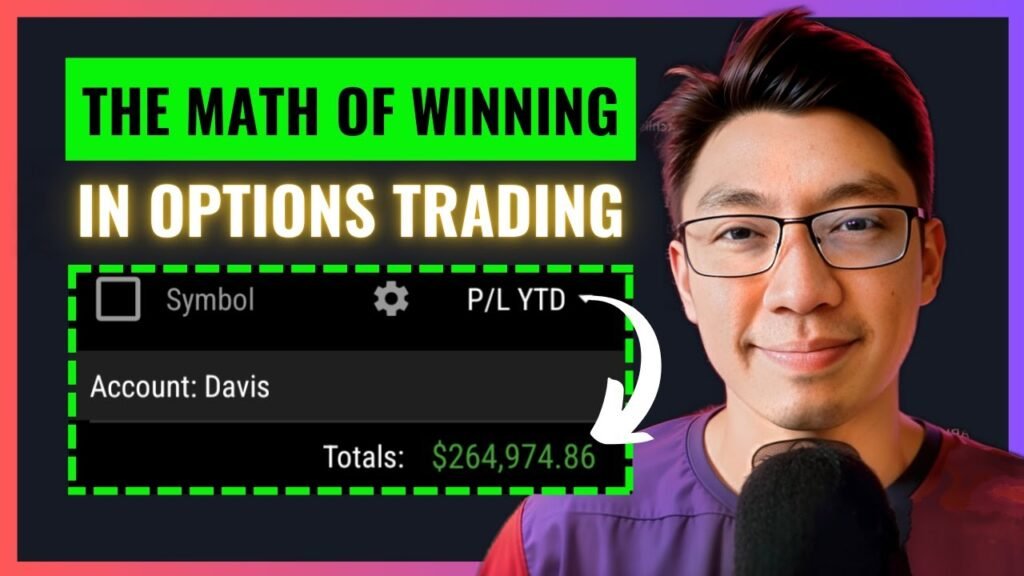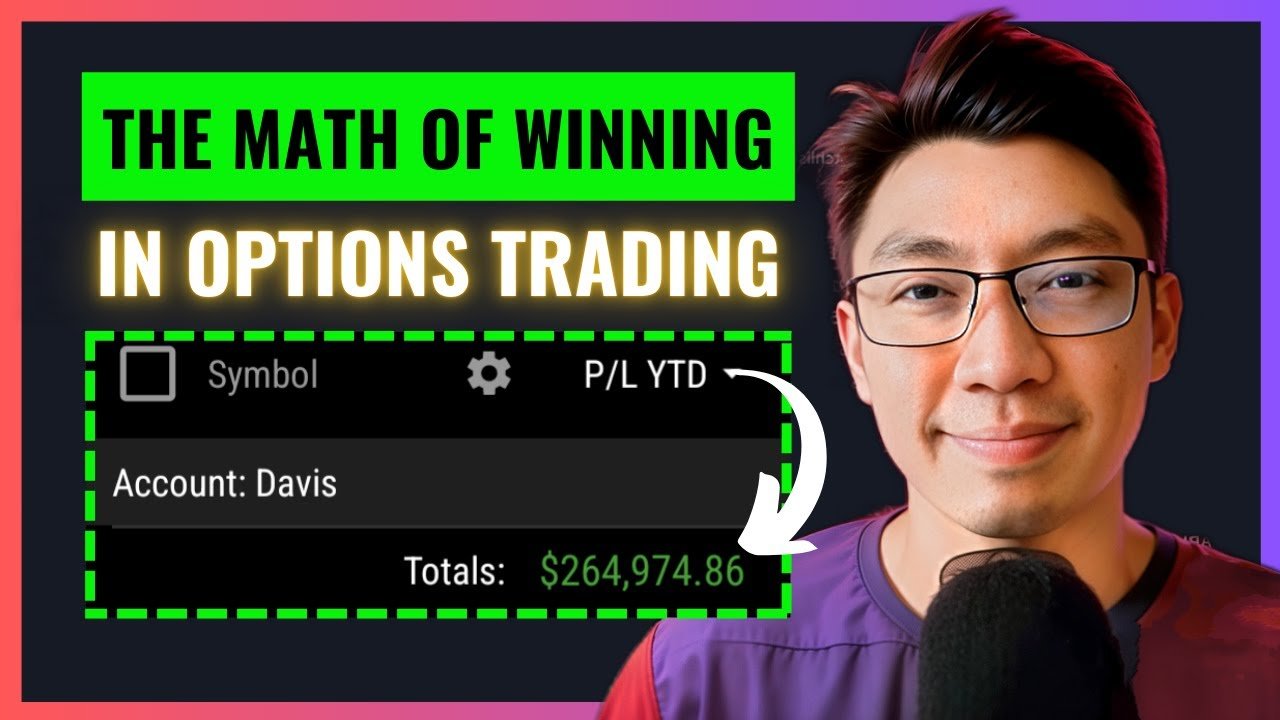Alright, in today’s video, we’ll be discussing the mathematics behind winning in options trading. Casinos have a profitable business model because their games are rigged in their favor, giving them a statistical edge in the long run. Similarly, as an options trader, you want to operate with an edge over the long term to ensure profitability. Understanding the probability of profit and win rate in options trading is crucial, as well as implementing proper risk and money management techniques. By following these principles, you can set yourself up for success and long-term profitability in options trading.
When it comes to options trading, you need to be aware of the theoretical win rate and the actual win rate based on your trade’s performance. Analyzing the expected move and comparing it to the realized move can provide valuable insights into your trading strategy’s effectiveness. This discrepancy between the theoretical and actual outcomes can give you an edge as an option seller, especially when trading options with a 45-day or longer timeframe. By understanding and leveraging these concepts, you can increase your chances of success and generate consistent profits through options trading.

The Basics of Selling Options
Definition of selling options
Selling options refers to a trading strategy where you, as the seller or writer, offer contracts that give the buyer the right, but not the obligation, to buy or sell a certain asset at a specified price within a set period. This practice involves generating income by collecting premiums from the options sold.
Benefits of selling options
One of the key advantages of selling options is the ability to generate regular income through the collection of premiums. Additionally, selling options can provide a way to profit in various market conditions, including sideways or trending markets. By having the flexibility to select strike prices and expiration dates, you can tailor your strategy to suit your risk tolerance and market outlook.
Risks involved in selling options
Although selling options can be a profitable strategy, it is essential to understand the risks involved. As a seller, you are exposed to unlimited risk if the market moves against your position. Furthermore, there is a possibility of significant losses if the underlying asset experiences a sharp price movement. It is crucial to implement risk management strategies to protect your capital and minimize potential losses.
How to Calculate Potential Profits
Understanding premium income
The premium income is the amount received by the option seller from the buyer in exchange for the rights associated with the options contract. This income serves as the primary source of profit for sellers. By analyzing premium levels in relation to market conditions and volatility, you can determine the potential profitability of your options selling strategy.
Calculating breakeven point
The breakeven point for an options selling strategy is the price level at which you neither make a profit nor incur a loss. It is essential to calculate this point to assess the risk-reward ratio of your trades accurately. By understanding your breakeven price, you can make informed decisions about your options selling positions.
Determining maximum profit potential
The maximum profit potential of a sold option contract is limited to the premium received at the time of sale. Sellers can realize their maximum profit if the option expires worthless or if the position is closed before expiration. By setting realistic profit targets and managing your trades effectively, you can optimize your profitability in options selling.
Risk Management Strategies
Setting stop-loss levels
Implementing stop-loss orders can help you protect your capital and limit potential losses in options selling. By establishing predetermined exit points based on your risk tolerance and trading plan, you can control and manage your downside risk effectively. Stop-loss levels are essential for safeguarding your portfolio from adverse market movements.
Diversifying your portfolio
Diversification is a key risk management strategy that involves spreading your investments across different assets to reduce overall risk exposure. By diversifying your options selling positions across various underlying assets, strike prices, and expiration dates, you can mitigate the impact of individual trade losses and improve the overall stability of your portfolio.
Position sizing for optimal risk management
Determining the appropriate position size for your options selling trades is crucial for effective risk management. By calculating the potential risk and reward of each trade in relation to your account size and risk tolerance, you can align your position sizes with your overall risk management goals. Proper position sizing helps you maintain a balanced portfolio and minimize the impact of adverse market movements.
Utilizing Different Options Trading Strategies
Generating income with credit spreads
Credit spreads involve selling an option with a higher premium and buying an option with a lower premium on the same underlying asset. This strategy allows you to collect a credit upfront while limiting your risk exposure. By leveraging credit spreads, you can generate consistent income and capitalize on market volatility.
Consistent income with the iron condor
The iron condor strategy combines selling out-of-the-money put and call options to create a range-bound position. This strategy aims to profit from stable market conditions and declining volatility. By managing risk and adjusting your positions when necessary, you can achieve consistent income with the iron condor strategy.
Recurring profits with the wheel strategy
The wheel strategy involves selling cash-secured put options on a stock you are willing to own. If the option is exercised, you acquire the stock at a predetermined price, allowing you to generate income from the premiums received. By adopting a systematic approach to the wheel strategy and managing your positions effectively, you can generate recurring profits over time.
Understanding Probability and Win Rate
Factors influencing probability of profit
The probability of profit in options trading is influenced by various factors, including volatility, time decay, and market conditions. By analyzing these factors and adjusting your trading strategy accordingly, you can enhance your chances of success and optimize your profitability. Understanding the key determinants of probability can help you make informed decisions in options trading.
Calculating win rate in options trading
The win rate in options trading refers to the percentage of profitable trades relative to the total number of trades executed. By tracking your win rate over time and identifying patterns in your trading performance, you can assess the effectiveness of your strategies and adapt to changing market conditions. Calculating your win rate allows you to measure your trading consistency and refine your approach for better results.
Interpreting statistical data for decision-making
Analyzing statistical data plays a critical role in options trading decision-making. By studying historical price movements, implied volatility levels, and option pricing models, you can make informed predictions about future market behavior. Leveraging statistical analysis helps you assess risk-reward ratios, identify trade opportunities, and optimize your trading strategies for long-term success.
The Law of Large Numbers in Options Trading
Concept of the law of large numbers
The law of large numbers states that as the sample size of observations increases, the mean of the observed values approaches the expected value. In options trading, this principle emphasizes the importance of executing a large number of trades to achieve consistent results and minimize the impact of individual outliers. By adhering to the law of large numbers, traders can rely on statistical probabilities and historical data to make strategic decisions.
Applying statistical principles in trading decisions
Integrating statistical principles into trading decisions involves analyzing data, calculating probabilities, and assessing risk factors. By utilizing statistical models and probability theory, traders can evaluate the potential outcomes of their trades and make informed choices based on empirical evidence. Applying statistical principles helps traders navigate uncertainty and enhance their decision-making process in options trading.
Long-term profitability through consistent trading practices
Achieving long-term profitability in options trading requires consistency and discipline in trading practices. By following a systematic approach, managing risk effectively, and adhering to proven strategies, traders can sustain profitability over time. Consistent trading practices, backed by statistical analysis and empirical evidence, can position traders for success in the dynamic options market.
Real-Life Case Studies
Success stories of profitable options traders
Real-life case studies showcase the experiences and achievements of successful options traders. By studying these success stories, traders can gain insights into effective trading strategies, risk management techniques, and decision-making processes. Learning from the experiences of profitable traders can inspire and motivate individuals to enhance their skills and achieve their trading goals.
Strategies employed in achieving profitability
Profitable options traders employ a range of strategies to maximize profitability and mitigate risk. These strategies may include selling credit spreads, implementing iron condors, and utilizing the wheel strategy. By combining various trading techniques and adapting to changing market conditions, traders can optimize their performance and capitalize on opportunities in the options market.
Lessons learned from practical experiences
Practical experiences offer valuable lessons for options traders at all levels. By reflecting on past trades, analyzing outcomes, and identifying areas for improvement, traders can enhance their skills and refine their strategies. Learning from practical experiences enables traders to develop resilience, adaptability, and a growth mindset essential for long-term success in options trading.
Resources for Further Learning
The Options Income Blueprint: The Credit Spreads Blueprint
The Options Income Blueprint provides a comprehensive guide to implementing credit spreads in options trading. By mastering the principles outlined in this blueprint, traders can enhance their understanding of credit spread strategies and optimize their income generation potential.
Mentorship program offered by Options with Davis
The mentorship program offered by Options with Davis provides personalized guidance and support to traders seeking to improve their options trading skills. Through one-on-one coaching, educational resources, and interactive sessions, traders can benefit from expert insights and practical guidance to elevate their trading performance.
Relevant videos and tutorials for additional insights
Accessing relevant videos and tutorials on options trading can broaden your knowledge and enhance your skills as a trader. Platforms like Options with Davis offer a diverse range of educational content, including tutorials on credit spreads, iron condors, and risk management strategies. By leveraging these resources, traders can stay informed, up-to-date, and well-equipped to navigate the complexities of options trading successfully.
Conclusion
Recap of key points discussed
In conclusion, selling options presents a unique opportunity for traders to generate income, manage risk effectively, and achieve long-term profitability. By understanding the fundamentals of options trading, implementing risk management strategies, and utilizing diverse trading techniques, you can optimize your trading performance and capitalize on market opportunities.
Encouragement for new traders to explore options trading
For new traders entering the world of options trading, it is essential to educate yourself, practice patience, and continuously refine your skills. Options trading offers a dynamic and rewarding environment for individuals willing to learn, adapt, and grow as traders. By embracing the challenges and opportunities of options trading, you can embark on a fulfilling journey towards financial success and personal growth.
Emphasis on the importance of continuous learning and practice
Continuous learning and practice are key components of success in options trading. By staying curious, seeking out new knowledge, and honing your skills through practice, you can enhance your trading acumen and develop a competitive edge in the market. Remember that success in options trading is a journey that requires dedication, resilience, and a commitment to ongoing growth and improvement. Stay focused, stay informed, and keep learning as you navigate the exciting world of options trading.
